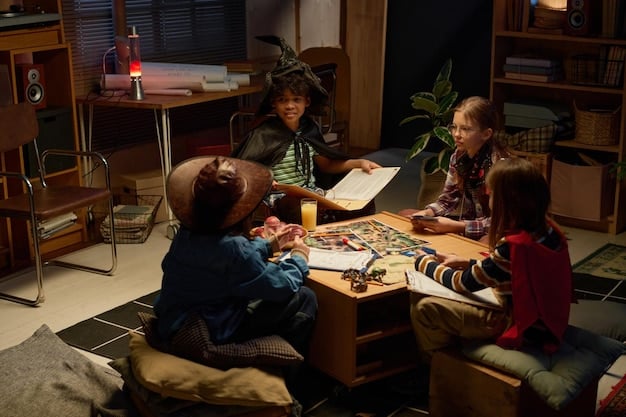The Power of Ensemble Casts in Crime Dramas: A Global Perspective

The Power of Ensemble Casts: Analyzing the Dynamics of Group Investigations in International Crime Dramas reveals how collaborative storytelling enhances narrative depth, cultural nuances, and audience engagement, offering a richer viewing experience in crime television.
The allure of international crime dramas often lies not just in the intricate plots and exotic locales, but also in the dynamic interplay of characters within an ensemble cast. The Power of Ensemble Casts: Analyzing the Dynamics of Group Investigations in International Crime Dramas reveals how these collaborative narratives contribute significantly to the depth, realism, and global appeal of the genre.
The Rise of Ensemble Casts in Crime Television
Ensemble casts have become increasingly prevalent in television, particularly within the crime drama genre. This shift reflects a growing audience appetite for complex narratives that explore multiple perspectives and delve into the intricacies of group dynamics.
But why are ensemble casts so effective in crime dramas? The answer lies in their ability to create a more immersive and multifaceted viewing experience. By presenting a range of characters, each with their own unique skills, backgrounds, and motivations, these shows can offer a more comprehensive and nuanced portrayal of the criminal justice system.
Enhanced Realism and Relatability
Ensemble casts contribute to a greater sense of realism by mirroring the collaborative nature of real-world law enforcement. In reality, investigations rarely rely on the efforts of a single individual. Instead, they involve a team of specialists, each bringing their expertise to the table.
Moreover, a diverse ensemble cast allows viewers to connect with characters from different walks of life, fostering a sense of relatability and understanding. This can lead to a more profound emotional investment in the story and its outcome.
- Real-world investigations rely on teamwork and diverse expertise.
- Ensemble casts mirror the collaborative nature of law enforcement.
- Diverse characters foster relatability and emotional investment.
The move towards ensemble casts in crime dramas mirrors real-world investigative dynamics, adding depth and authenticity to the storytelling.
Cultural Representation and Global Appeal
International crime dramas often feature ensemble casts comprised of actors from various cultural backgrounds. This deliberate choice not only enhances the authenticity of the storytelling, but also expands the show’s appeal to a global audience.
By showcasing a diverse range of perspectives and experiences, these shows can address complex social and political issues in a way that resonates with viewers from different cultural backgrounds. This can lead to a greater understanding and appreciation of diverse cultures and perspectives.

Breaking Down Stereotypes
Ensemble casts can play a crucial role in challenging stereotypes and promoting positive representation. By showcasing characters from marginalized communities in positions of authority and competence, these shows can help to break down harmful stereotypes and promote a more inclusive worldview.
Furthermore, by exploring the unique challenges and perspectives of characters from different cultural backgrounds, these shows can foster empathy and understanding among viewers.
- Diverse casts enhance authenticity and global appeal.
- Shows address complex social and political issues.
- Characters challenge stereotypes and promote empathy.
The strategic use of diverse ensemble casts in international crime dramas breaks down stereotypes and fosters a global connection through shared stories.
Analyzing Character Dynamics and Relationships
The success of an ensemble cast often hinges on the dynamic relationships between its members. The interplay of personalities, skills, and motivations can create a compelling and unpredictable narrative that keeps viewers engaged.
By exploring the complexities of human relationships within the context of a high-stakes crime investigation, writers can create a gripping and emotionally resonant story that transcends the boundaries of the genre.
Conflict and Cooperation
The dynamic between characters in an ensemble cast can be a fertile ground for both conflict and cooperation. Disagreements over investigative strategies, clashes of personality, and personal rivalries can all contribute to dramatic tension.
At the same time, the need to solve the crime often forces characters to overcome their differences and work together towards a common goal. This interplay of conflict and cooperation can create a compelling and realistic portrayal of teamwork under pressure.
- Character dynamics create compelling narratives.
- Conflict and cooperation generate dramatic tension.
- Teamwork under pressure is a key element of the genre.
The interplay of conflict and cooperation among characters in ensemble crime dramas drives the narrative and creates engaging storylines.
Case Studies: Notable Ensemble Casts in International Crime Dramas
Several international crime dramas have successfully utilized ensemble casts to create compelling and critically acclaimed television. These shows offer valuable insights into the power of collaborative storytelling and the impact of diverse representation.
Here, we will briefly examine a few notable examples, focusing on the specific ways in which their ensemble casts contribute to the overall success of the show.
“Criminal Minds: Beyond Borders”
A spin-off of the popular “Criminal Minds” series, “Beyond Borders” follows a team of FBI agents who specialize in solving crimes involving American citizens abroad. The show’s ensemble cast is comprised of actors from diverse cultural backgrounds, reflecting the global nature of their investigations.
The dynamic interplay between the characters, each with their unique skills and perspectives, allows the show to explore complex cultural issues and provide a nuanced portrayal of international law enforcement.
“Luther”
While primarily focused on the brilliant yet troubled detective John Luther, “Luther” benefits from a strong supporting cast that adds depth and complexity to the narrative. From his complicated relationship with Alice Morgan to his partnerships with various police colleagues, Luther’s interactions with other characters are essential to the show’s appeal.
- “Criminal Minds: Beyond Borders” features a diverse team tackling international crimes.
- “Luther” benefits from a strong supporting cast enhancing its protagonist’s story.
These case studies highlight how ensemble casts can enhance narrative depth and cultural representation in international crime dramas.
Writing for Ensemble Casts: Challenges and Opportunities
Writing for an ensemble cast presents both challenges and opportunities for screenwriters. On the one hand, it requires juggling multiple storylines and character arcs, ensuring that each member of the cast receives adequate attention and development.
On the other hand, it allows for a more complex and nuanced exploration of the themes and issues at the heart of the story. By presenting multiple perspectives and experiences, writers can create a richer and more engaging narrative that resonates with a wider audience.

Balancing Screen Time and Character Development
One of the key challenges of writing for an ensemble cast is balancing screen time and ensuring that each character receives adequate development. This requires careful planning and a deep understanding of each character’s motivations, goals, and relationships with other members of the cast.
Writers must also be mindful of the overall narrative structure, ensuring that each character’s storyline contributes to the overarching plot and thematic concerns of the show.
- Screenwriters face challenges in balancing screen time for diverse casts.
- Each character’s storyline must contribute to the overarching plot.
Skillful writing is essential to ensure balanced character development and cohesive storytelling in ensemble crime dramas.
The Future of Ensemble Casts in Crime Dramas
The trend towards ensemble casts in crime dramas shows no sign of slowing down. As audiences increasingly demand complex and nuanced storytelling, these collaborative narratives are likely to become even more prevalent in the future.
Furthermore, the rise of streaming services and global co-productions is creating new opportunities for international crime dramas to reach a wider audience and showcase diverse perspectives and experiences.
Embracing Diversity and Inclusion
The future of ensemble casts in crime dramas will likely be shaped by a greater emphasis on diversity and inclusion. As the entertainment industry becomes more aware of the importance of representation, we can expect to see more shows that feature casts comprised of actors from a wide range of cultural backgrounds, sexual orientations, and gender identities.
This will not only enhance the authenticity of the storytelling, but also provide viewers with a more inclusive and representative portrayal of the world around them.
- Ensemble casts will likely become even more prevalent.
- Streaming services offer new opportunities for international crime dramas.
- Greater emphasis on diversity and inclusion is expected.
The future of ensemble cast promises to be more inclusive, diverse, and globally connected in crime drama narratives.
| Key Aspect | Brief Description |
|---|---|
| 🤝 Team Dynamics | Exploration of relationships between diverse characters. |
| 🌍 Cultural Representation | Showcasing diverse perspectives and experiences. |
| 📢 Breaking Stereotypes | Challenging harmful stereotypes through character roles. |
| 🎬 Realism and Relatability | Enhancing authenticity through diverse characters. |
Frequently Asked Questions
▼
Ensemble casts allow for diverse perspectives and complex character dynamics, mirroring real-world investigative teams and offering a richer narrative experience that appeals to a broad audience.
▼
By featuring actors from diverse backgrounds, ensemble casts provide a platform for showcasing a variety of cultural perspectives, fostering empathy, and addressing complex social and political issues.
▼
Writers must balance screen time, develop individual character arcs, and ensure that each character’s storyline contributes to the overarching plot, requiring careful planning and a deep understanding of each character.
▼
Ensemble casts mirror the collaborative nature of real-world law enforcement, where investigations involve a team of specialists, each bringing their expertise and unique skills to the table.
▼
The future will likely emphasize greater diversity and inclusion, showcasing actors from a wide range of backgrounds and identities, enhancing authenticity and providing viewers with a more inclusive portrayal of the world.
Conclusion
In conclusion, **The Power of Ensemble Casts: Analyzing the Dynamics of Group Investigations in International Crime Dramas** illustrates the immense value and influence of collaborative storytelling in the genre. By promoting inclusivity, deepening narratives, and mirroring real-world complexities, ensemble casts are set to remain a key component of successful crime dramas worldwide.





